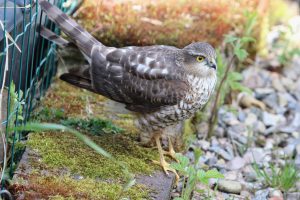 Sparrowhawks are by far the most common bird of prey you are likely to see in your garden although with the speed they move it is more often than not just a blur of wings, The reason for this is that the bird will mainly be hunting small birds such as chaffinches and its hunting technique is to surprise such small prey. The sparrowhawk needs the element of surprise to get advantage over its prey. They will often take a regular route through a garden using the cover of a hedge or a garden shed to get close to the feeding birds. Then suddenly, often with a flick of the wings, it will turn and take a bird. The type of prey very much depends on whether the sparrowhawk is a male or female as there is a great deal of difference in their size. The female is by far the largest being roughly twice the weight of the smaller males. The males normally take small birds such chaffinches, yellowhammers and great tits whilst the larger females will take blackbirds and starlings and may even take larger birds such as woodpigeons. This is a reflection of the role of the two sexes in the breeding season when the male has to be more agile in taking birds as he is the main provider. The female has the egg laying and incubation to take into account.
Sparrowhawks are by far the most common bird of prey you are likely to see in your garden although with the speed they move it is more often than not just a blur of wings, The reason for this is that the bird will mainly be hunting small birds such as chaffinches and its hunting technique is to surprise such small prey. The sparrowhawk needs the element of surprise to get advantage over its prey. They will often take a regular route through a garden using the cover of a hedge or a garden shed to get close to the feeding birds. Then suddenly, often with a flick of the wings, it will turn and take a bird. The type of prey very much depends on whether the sparrowhawk is a male or female as there is a great deal of difference in their size. The female is by far the largest being roughly twice the weight of the smaller males. The males normally take small birds such chaffinches, yellowhammers and great tits whilst the larger females will take blackbirds and starlings and may even take larger birds such as woodpigeons. This is a reflection of the role of the two sexes in the breeding season when the male has to be more agile in taking birds as he is the main provider. The female has the egg laying and incubation to take into account.
There has always been a great deal of controversy over the effect the sparrowhawk has on the number of small birds in the garden. A great deal of research has been carried out, particularly by the British Trust for Ornithology, and the overall opinion is that they have little or no affect. The reason for this is that the birds they take as prey are either birds in poor condition or birds that will die anyway for various reasons such as the amount of overall food available. The problem is that many of us are garden birdwatchers and to see a siskin, for example, being torn apart by a sparrrowhawk is emotional. If this gets too much then one thing you can do is to move the feeding station around the garden every so often. This means that the sparrowhawk does not have the same flight pattern to use. On the other hand think of the sparrowhawk chicks in the nests waiting to be fed. It is swings and roundabouts.
Interestingly the success of the sparrowhawk’s hunting is fairly low and the bird in the photograph is a good example. It is a young male bird and it had gone for a group of house sparrows that had fled into a large bush. The sparrowhawk even went into the bush and I could see him diving in between the branches trying to get its quarry, to no avail. In the end it dropped to the ground and looked thoroughly confused. It was good chance to photograph it and see the salient features. One is the surprisingly long yellow legs and the long grey tail crossed with 4-5 dark bars. The fierce expression on its face is marked and you can see the start of the white eye stripe. There are thought to be around 10,000 breeding pairs in Scotland which is a dramatic increase after much persecution in the early 1900s. However, there has now been a modest decline especially in intensively farmed areas. As with other birds of prey there is still an element of illegal persecution especially where pheasants and partridges are introduced for shooting
Tags: highland birds
